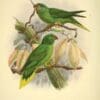Palm Lorikeet
Also known as:
Green Palm Lorikeet, Vanuatu Lorikeet
Also known as:
Green Palm Lorikeet, Vanuatu Lorikeet
DID YOU KNOW?
These parrots are virtually undetectable because of their resemblance to the surrounding foliage. They are only found by their occasional high, shrill calls.

Charmosyna

palmarum
Size:
17 cm (6.6 in)
Weight:
35 g (1.2 oz)
Subspecies including nominate:
one
Colour Adult:
Both adults red on chin, lores, and base of bill (less in female); mantle washed with olive/brown, often missing in female; underwing band absent; green tail with wide yellow tip; orange beak; yellow eye.
Colour Juvenile:
As in female but with orange/brown beak and brown/yellow eye.
Call:
Calls are short and high-pitched; more rapid when given in flight. Shrill twittering heard when bird is feeding and softer notes given while at rest.
More Information:
Content Sources:
CITES
BirdLife International
Cornell Lab of Ornithology/Birds of the World
A Guide to Parrots of the World, Juniper and Parr, 1998
Parrots of the World, Forshaw, 2006. 2010 edition
Lexicon of Parrots, Thomas Arndt.
Captive Status:
Not found in aviculture.
Longevity:
—
Housing:
Enclosure, easily cleaned, 2.5 x 1 x 2 m (8 x 3 x 6 ft). Minimum temperature 20 C (68 F), not less than 24 C (75 F) during acclimatisation.
Diet:
Lory nectar of thin porridge, honey, pollen, brewer’s yeast, vitamins and mineral supplements or commercial nectar; different fruits such as pear, peach, passion fruit and apple; greenfood such as kale and dandelion; different wild edible berries (rowan, pyracanthas and rose hips).
Enrichment:
—
Nest Box Size:
Box 20 x 20 x 40 cm (10 x 10 x 20 in).
Clutch Size:
Probably 2.
Fledging Age:
—
Hatch Weight:
—
Peak Weight:
—
Weaning Weight:
—
World Population:
5000-20,000 mature individuals, decreasing.
IUCN Red List Status:
Least Concern
CITES Listing:
Appendix II
Threat Summary:
A BirdLife “restricted-range” species. Threats include avian malaria, cyclones and natural cycles. Lowland forest, which may or may not be used by this species, is being cleared for agriculture, timber and commercial logging.
Range:
Santa Cruz, Duff and possibly Reef Islands, easternmost Solomon Islands, and Vanuatu, including Banks Islands.
Habitat:
Found above 1000 m (3280 ft) in undisturbed montane forest, irregularly in lowlands.
Wild Diet:
Feeds on nectar and pollen of various trees, palms, lianas and shrubs, notably from flowers of sago palms (Metroxylon rumphii) and Erythrina; also takes Ficus figs and berries.
Ecology and Behaviour:
Nomadic, traveling widely between feeding sites in pairs and medium-sized flocks. Appears in lowlands sporadically. Pair bonds strong in large flocks.
Clutch and Egg Size:
Possibly 2 eggs.
Breeding Season:
Beginning in October, young in December. Nest is in hollow tree limb or trunk.
Related Links:
—

